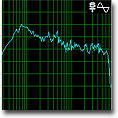Extended SSB Hi-fi Apologetics - Page 1 |
|
||||||||||||||||||||||||||||||||||||||||||||||||||||||||||||||||||||||||||||||||||||||||||||||||||||||||||||||||||||||
| FCC Part §97.1 - Basis and Purpose of the Amateur Radio Service | |
| (b) | Continuation and extension of the amateur's proven ability to contribute to the advancement of the radio art. |
| (c) | Encouragement and improvement of the amateur service through rules which provide for advancing skills in both the communications and technical phases of the art. |
| (d) | Expansion of the existing reservoir within the amateur radio service of trained operators, technicians and electronic experts. |
It's very clear from the beggining of the FCC rulebook that "Advancing the State of the Art","Technical Skills", "Becoming technicians and electronic experts" is at the top of the desired effect of the Amateur Radio service! Let us never forget this important and fundamental philosophy of "HAM RADIO" !!!
Remember, experimentation and exploration of this electronic art is at the very core of Ham Radio...
The rules decare it so !!
These terms can be somewhat confusing since true "Hi-fi" is an old stereophonic audio term referring to true High-fidelity audio - e.g. 20Hz ~ 20kHz of flat frequency response with very low Total Harmonic distortion (THD) and good Signal-To-Noise (S/N) characteristics. By this definition, any Amateur Radio transmission hardly qualifies as true Hi-fi
However, speaking in a relative fashion as compared to standard SSB practice, I would like to define the terms we use as follows in the table below as a reference only:
eSSB = Extended Single Sideband
Note: "Extended SSB" or "eSSB" is any J3E SSB transmission that exceeds the audio bandwidth of standard or traditional 2.9kHz SSB J3E modes (ITU 2K90J3E) starting at 3kHz (ITU 3K00J3E), in order to support the fidelity required and desired for relative high fidelity, full range clean and articulate vocal audio. - See table below:
SSB & eSSB EXAMPLES
| STANDARD SSB MODES (Subjective Descriptions) |
BANDWIDTH |
FREQUENCY RESPONSE @ -6dB Points |
ITU DESIGNATOR (Technical Descriptions) |
| Standard SSB (Narrow) |
2 kHz |
400 Hz ~ 2.4 kHz |
2K00J3E |
| Standard SSB (Medium) |
2.4 kHz |
300 Hz ~ 2.7 kHz |
2K40J3E |
| Standard SSB (Wide-1) |
2.7 kHz |
200 Hz ~ 2.9 kHz |
2K70J3E |
| Standard SSB (Wide-2) |
2.9 kHz |
100 Hz ~ 3.0 kHz |
2K90J3E |
| EXTENDED SSB MODES (Subjective Descriptions) |
BANDWIDTH |
FREQUENCY RESPONSE @ -6dB Points |
ITU DESIGNATOR (Technical Descriptions) |
| eSSB (Narrow-1a) |
3 kHz |
100 Hz ~ 3.10 kHz |
3K00J3E |
eSSB (Narrow-1b) |
3 kHz |
50 Hz ~ 3.05 kHz |
3K00J3E |
| eSSB (Narrow-2) |
3.5 kHz |
50 Hz ~ 3.55 kHz |
3K50J3E |
| eSSB (Medium-1) |
4 kHz |
50 Hz ~ 4.05 kHz |
4K00J3E |
| eSSB (Medium-2) |
4.5 kHz |
50 Hz ~ 4.55 kHz |
4K50J3E |
| eSSB (Wide-1) |
5 kHz |
50 Hz ~ 5.05 kHz |
5K00J3E |
| eSSB (Wide-2) |
6 kHz |
50 Hz ~ 6.05 kHz |
6K00J3E |
Copyright © 2003 |
|||
In the scheme above, 3 kHz of audio bandwidth was the chosen criteria or threshold qualifying a signal as eSSB. The reason for this, is that high frequency audio from 3 kHz and above starts to
support a significant difference in clarity, "openness" and fidelity of the audio signal that better reproduces natural energy found in the human voice. Even though vocal chord energy diminishes rapidly above 3 kHz, the all
important high frequency consonants such as the "S", "T", "SH", "CH" "K" and "Z" that are formed with various combinations of the tongue, roof of the mouth and teeth are well
above 3 kHz and essential for high definition speech with less listener fatigue. See the excellent Polycom White paper on: "The Effects of Bandwidth vs. Speech Intelligibility".
To listen to a 10 minute eSSB segment from Art Bell on his "Coast to Coast" Broadcast, and from a 10 minute interview I had with "This Week In Amateur Radio" regarding eSSB, click
here.
Copyright © 2005 TWIAR - All Rights Reserved
A HYPOTHETICAL SCENARIO:
 topic and not an artifact that anyone is hearing within 10kHz of the TX passband!
topic and not an artifact that anyone is hearing within 10kHz of the TX passband!Here are the test results, graphs and data, of my spectral measurements using my complete audio rack system, Kenwood TS-850S and Kenwood DSP-100 into my Heathkit SB200 amp (500w) and TH7 antenna on transmit and a borrowed commercial TEN-TEC RX340 receiver with a dead-flat 10kHz receive bandwidth so that my entire TX passband can be viewed in it's entirety:
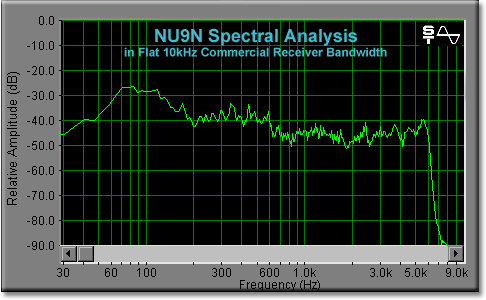
AF Spectral Analysis
1kHz ~ 10kHz Close-up of above graph
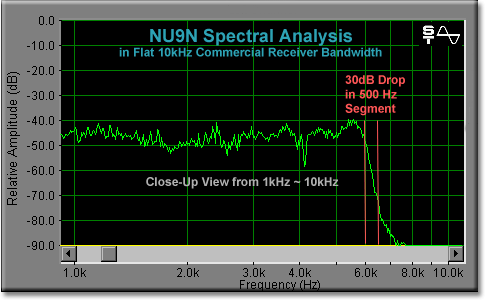
AF Spectral Analysis
Bandwidth of the above graphs were measured in the Audio domain.
RF Spectral Analysis in detail will be done in the near future with the results displayed on the page.
The technical data / AF measurements as per the graphs are as follows...
| 100Hz |
@ | -30dB | 0dB Reference |
| 1kHz |
@ | -45dB | down -15dB |
| 5kHz |
@ | -45dB | down -15dB |
| 7kHz |
@ | -90dB | down -60dB |
| 8kHz |
@ | ----- | not measurable |
| 9kHz |
@ | ----- | not measurable |
| 1kHz |
@ | -45dB | 0dB Reference |
| 5kHz |
@ | -45dB | 0dB |
| 7kHz |
@ | -90dB | down -45dB |
| 8kHz |
@ | ----- | not measurable |
| 9kHz |
@ | ----- | not measurable |
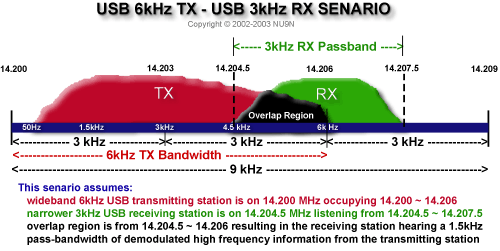
There are those of us who are experimenting with 6kHz wide-band SSB and enjoying near AM quality audio via Single Sideband without the AM artifacts, (i.e. Double Sideband with Carrier). We could, legally, do 6kHz wide (or more) AM anywhere on 20m if we wanted to, but then other stations would have to contend with annoying carriers and heterodyning effects that SSB was designed to eliminate in the first place. By the way, SSB was not developed specifically to be narrow in order to squeeze more stations on the band (although this was one of the attractive attributes about it) but rather developed to relieve the bands of the annoying heterodyning and poor efficiency of AM. It has been argued that SSB was developed as a "spectrum conscious mode" Again, this was not the original intent, but certainly has this benefit since a given SSB signal requires only one half of the RF bandwidth of AM for the same audio bandwidth response. See the illustration below:
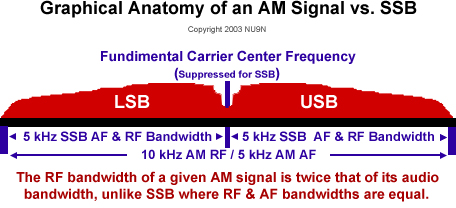
Additionally, SSB technology presented some cost benefits over AM as well. AM requires twice the RF bandwidth to achieve the same audio bandwidth of that generated by SSB. However, original pre-DSP analog
SSB technology was inherently deficient in exceeding 3kHz because of opposite sideband and carrier suppression problems due to carrier-point placement and cost of the filters and engineering needed to achieve wider bandwidths. This is no
longer the case due to advancements in technology, a.k.a. DSP! Also, wide band digitally processed SSB is a much more efficient way of amplitude modulation than AM ever was! Again, for a true AM signal to have the same
audio information and quality as a 6kHz wide SSB signal, it would have to be 12kHz wide! ... 6kHz USB plus 6kHz LSB and a carrier, which would, by the way, be perfectly legal to do.
DSP rigs do have the advantage over their analog counterparts because they are using the phasing method of sideband generation with near perfect results due to the elimination of component value drift. The unwanted
sideband rejection from 0 ~ 100Hz away from the carrier is unmatched by filter units attempting to pass 50Hz and up in their wanted sideband. That's the key; filter skirts aren't sharp enough to have excellent unwanted sideband rejection
and excellent low frequency response in the wanted sideband. The resulting audio quality of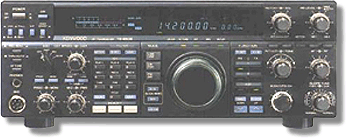 the wider digitally produced SSB is nothing short of phenomenal when compared to it's analog or digital SSB kHz 3kHz or narrower counterpart. It has been argued that any audio information above
3kHz is poor AF / RF management and is a waste of precious bandwidth. But let me point out that a clean, well managed wide band DSP SSB signal uses less bandwidth than that of a poorly managed 2.4kHz wide SSB signal using 6kHz or more bandwidth
via distortion, I.M.D. and/or splatter effects! These kind of sloppy narrow-band signals are found much too frequently on the amateur bands (especially during contest weekends) and ultimately occupy more bandwidth than anyone doing
high quality wide band DSP enhanced sideband, since the wide-band SSB operators are usually very meticulous about their modulation quality to begin with... This is, after all, why we spend countless hours (more than the typical ham who
just plugs and plays) tweaking and adjusting our audio to a tailored, Hi-Fi, smooth, clean sound, nearly emulating what AM broadcasters have been doing for years, without the excessive bandwidth required by AM broadcast!
the wider digitally produced SSB is nothing short of phenomenal when compared to it's analog or digital SSB kHz 3kHz or narrower counterpart. It has been argued that any audio information above
3kHz is poor AF / RF management and is a waste of precious bandwidth. But let me point out that a clean, well managed wide band DSP SSB signal uses less bandwidth than that of a poorly managed 2.4kHz wide SSB signal using 6kHz or more bandwidth
via distortion, I.M.D. and/or splatter effects! These kind of sloppy narrow-band signals are found much too frequently on the amateur bands (especially during contest weekends) and ultimately occupy more bandwidth than anyone doing
high quality wide band DSP enhanced sideband, since the wide-band SSB operators are usually very meticulous about their modulation quality to begin with... This is, after all, why we spend countless hours (more than the typical ham who
just plugs and plays) tweaking and adjusting our audio to a tailored, Hi-Fi, smooth, clean sound, nearly emulating what AM broadcasters have been doing for years, without the excessive bandwidth required by AM broadcast!
As for the wasted bandwidth issue regarding 3kHz plus audio, let me point out that there are some key frequencies in human speech, especially in the 4~5kHz range that are important for defining speech
recognition. If this were not true, AM broadcasters would have used a 3kHz audio bandwidth years ago so they could squeeze hundreds if not thousands of more stations in the 530 ~ 1700 kHz broadcast window. And remember, 99% of commercial
broadcast AM is "TALK RADIO"! In fact, the total allowable transmit bandwidth of U.S. commercial AM broadcast stations is +/- 9.5 kHz, or a total transmit bandwidth of 19 kHz, since broadcast AM contains two sidebands (USB and
LSB) of 9.5kHz audio information each.
No filters have been "ripped out" of the Kenwood TS-850S, nor has the equipment been "hacked-up" electrically to produce wide transmitter characteristics. The 850/DSP100 combination can do this easily, as per the instruction manual (even 12kHz Double Side Band - which is also legal) and has been FCC type accepted and approved!
Operators who complain that we "hacked-up" our radios to produce broad signals have a weak argument. Capable bandwidth is a manufactures issue, not the users. We hams must follow part 97 of the FCC regulations. However, building and modifying gear is the very soul of ham radio experimentation. How many operators have built their own transmitters, receivers, linear amplifiers and tuners? - Many!
FCC Part 97.307(a)
Also, the "Emission Type" is another one of those terms that can be very ambiguous in definition. Technically, SSB is referred to as J3E. 3kHz wide SSB is referred to, technically as 3K00J3E. 4kHz wide SSB is referred to as 4K00J3E. 4.5kHz wide SSB audio would referred to as 4K50J3E, etc...
For more on emission standards, click here to see the FCC Part-2-201 PDF document.
After reading the whole document, it is clear that the interpretation of 47 CFR 2.202(b) is to reflect the *minimum* necessary bandwidth sufficient to "... ensure the transmission of information at the rate and with the quality required for the system employed." So, it would appear that this rule simply establishes a *minimum* threshold, not a *maximum* bandwidth for the desired communications. It also appears to me that the "Table Of Necessary Bandwidths" gives us a criteria for determining the correct alpha-numerical designator as seen in the table reference.
FCC-DA-04-3661A1 Ruling on RM-10470
The FCC Rules on Occupied Bandwidth:
The following is an exert taken directly from the FCC ruling "FCC-DA-04-3661A1" regarding the ruling on "RM-10470" that was a petition filed by W4MDL (ex W0YR) and W6FDR who wanted a ruling made that would limit SSB bandwidth at 2.8kHz and AM at 5.4kHz. The FCC response was as follows:
I. BACKGROUND
9. We have carefully considered all comments filed, including comments filed in support of the Petition, and some alternative proposals. We conclude that Petitioners' request for an amendment of our rules is inconsistent with the Commission's objective of encouraging the experimental aspects of amateur radio service. The Petition also fails to demonstrate that a deviation from the Commission's longstanding practice of allowing operating flexibility within the amateur service community is either warranted or necessary. In this regard, we note that most operators use the amateur service spectrum in a manner consistent with the basic purpose of the amateur service. Further, we believe that our existing rules -- including the provisions that no amateur station transmission shall occupy more bandwidth than necessary for the information rate and emission type being transmitted, in accordance with good amateur practice, and that emissions outside the necessary bandwidth must not cause interference to operations on adjacent frequencies -- are adequate to address any noncompliant practices by amateur operators.
10. Regarding Petitioner's request that amateur stations transmitting emission type A3E not be authorized to occupy more than 5.6 KHz bandwidth on amateur frequencies below 28.8 MHz, we agree with commenters who note Petitioners have not demonstrated there to be a particular problem with stations that transmit AM emissions. Moreover, the Commission has previously declined to restrict bandwidth for AM because to do so would be inconsistent with the basic purpose of amateur service and our desire to offer amateur operators the opportunity to experiment with various types.
11. We continue to encourage amateur operators to act in good faith in the exercise of their operations as required by Section 97.101(d) of the Commission's rules,41 which provides that no amateur operator shall willfully or maliciously interfere with or cause interference to any radio communication or signal. The Commission's Enforcement Bureau will continue to monitor nonconforming activities of operators not abiding by the Commission rules through its complaint process. In instances of willful and malicious interference, the Enforcement Bureau will not hesitate to take appropriate action. In sum, we are not persuaded by Petitioner's claims that bandwidth restrictions are necessary, and, therefore, deny the Petition.
12. IT IS ORDERED that the Petition for Rulemaking, RM-10740, submitted by Michael D. Lonneke and Melvin J. Ladisky on May 27, 2003, IS DENIED. This action is taken under delegated authority pursuant to Sections 0.131 and 0.331 of the Commission's Rules, 47 C.F.R. §§ 0.131, 0.331.
FEDERAL COMMUNICATIONS COMMISSION
Michael J. Wilhelm
Chief, Public Safety and Critical Infrastructure Division
Wireless Telecommunications Bureau
As indicated above, the petition died a horrible death not only with the FCC, but with 85% of the amateurs who responded in the comment filing period. This was the correct decision made by the FCC and amateurs. This documented decision restored my faith that the Commission has not lost site of the basic purpose and mandate of the amateur radio service. Good call guys!
| The production of clean, high quality, relative full fidelity SSB audio within a reasonable Amateur Radio passband width, required for this
fidelity. |
| The exploration and experimentation of both old and new audio technology and of the equipment needed to accomplish our goals while staying
within our individual financial budgets. |
| The promotion of such experimentation within this perceived high fidelity audio domain without being an offense, or causing malicious interference
to those who do or do not participate, while abiding to FCC Part 97 rules and regulations. |
| The desire and accomplishment of pushing the envelope of excellence. |
| The establishing of lasting friendships in which those who are interested in quality modulation can share in the richness of the experience. |
| The enhancement of technical skills through experimentation of such an endeavor which is, after all, one of the mandates of Amateur Radio. |
W9AC - Paul
| John M. Anning - NU9N
e-Mail: |
© 2024 NU9N - All rights reserved Site Design by IcyColors.com |
Apologetics 1 | Apologetics 2 | Audio Glossary | Donate | eSSB Mods | eSSB Ready Rigs | Transmitter Settings for eSSB
File Downloads | News | Radio Connections | Transmitter Settings | Scope Your Audio | Site Map | Site Search | T-Pad Calculator


